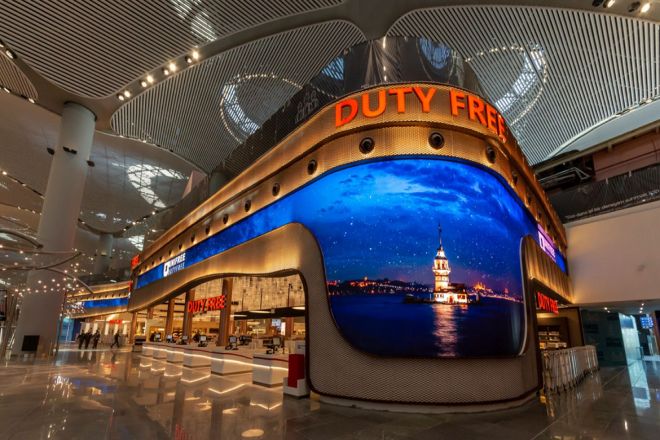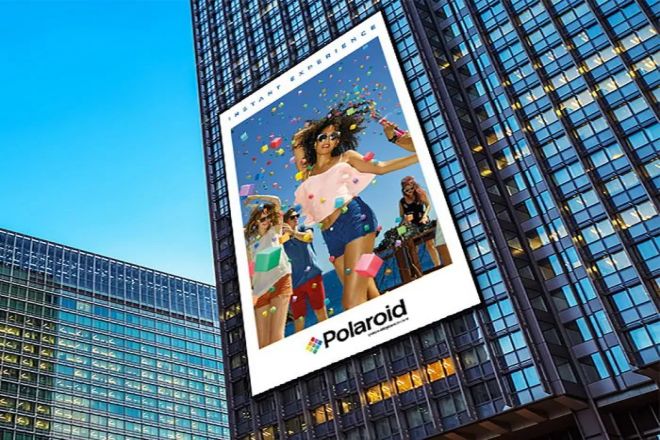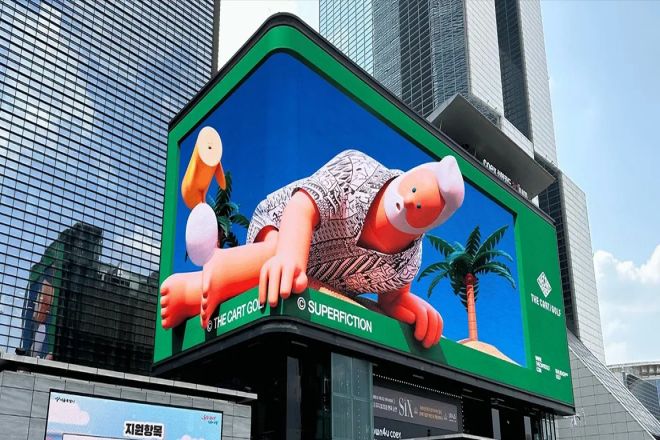Introduction

The video source of LED display, as its core driving force, not only carries the transmission of information but also is the starting point of the visual feast. Its quality directly determines the clarity of the picture on the display, the vividness of the color, and the accurate transmission of information.
For the cutting-edge 3D LED display, the 3D video source is an indispensable soul, which gives the picture depth and layers, allowing the audience to enjoy an immersive three-dimensional visual experience without auxiliary equipment.
This integration of technology not only requires the video source to have a high degree of realism and rich details but also tests the display’s outstanding ability in image processing, color restoration, and three-dimensional effect presentation and jointly promotes visual art to a new height.
1. Color and brightness of video sources of LED display screens
You have already outlined the key points well regarding the color and brightness requirements of video sources of LED display screens.
Here, I will further refine and supplement some relevant information to understand more fully the importance of these requirements and how to achieve them.
1). Color requirements
1.1). High saturation and contrast
- High saturation:
High saturation means that the colors are brighter and more vivid and can more accurately show the details and color levels of the video content.
The pixels of LED display screens can emit relatively pure color light, so the rich color information in the video source can be directly converted into impressive visual effects on the screen.
- High contrast:
Video sources with high contrast can clearly distinguish between bright and dark parts in the image, making the picture more three-dimensional and layered. For LED displays, high contrast not only enhances visual impact but also helps maintain image clarity when viewed from a distance.
1.2). Black background recommendation (especially for transparent LED displays)
- Transparent feature utilization:
Transparent LED displays can blend into the environment and create a unique visual effect due to their unique transparent backplane design. Black backgrounds can not only visually enhance this sense of integration but also reduce energy consumption by reducing light transmission.
- Enhanced sense of hierarchy:
The strong contrast between the black background and the bright content can form a distinct layer visually and attract the audience’s attention. This design is particularly suitable for occasions where specific information needs to be highlighted, or a specific atmosphere needs to be created.
2). Brightness adjustment
2.1). Adapt to ambient light
- Automatically adjust brightness:
Modern LED displays are usually equipped with brightness sensors and intelligent control systems that can automatically adjust screen brightness according to changes in ambient light. This automatic adjustment function ensures that viewers can get the best viewing experience under different lighting conditions.
- Manual adjustment option:
In addition to automatic adjustment, many LED displays also provide the option of manually adjusting brightness so that users can make fine adjustments according to actual needs. Manual adjustment is usually achieved through the display’s control software or remote control, which is easy and quick to operate.
2.2). Importance of brightness adjustment
- Energy saving and consumption reduction:
Properly reducing the screen brightness in a dimly lit environment can not only reduce energy consumption but also extend the service life of the LED display.
- Protect eyesight:
Excessive brightness may have an adverse effect on the audience’s eyesight. Reasonable brightness adjustment helps protect the audience’s eyesight health.
- Improve viewing experience:
Whether in outdoor or indoor environments, keeping the picture clear and visible through brightness adjustment is one of the key factors to improve the audience’s viewing experience.
2. Resolution and clarity of the video source of the LED display

1). Resolution and clarity of the video source of the LED display
- HD standard
With the continuous development of digital display technology, high-definition display has become a basic requirement.
For general-purpose LED displays, such as commercial advertisements, live sports events, public information releases, etc., the resolution of the video source should be at least 1920*1080 (also known as Full HD or 2K).
This resolution standard ensures that the video content is presented on the screen with clear picture quality to meet the viewing needs of most viewers.
- High-resolution requirements
However, in situations where higher image quality and more delicate visual effects are sought, such as large command and dispatch centers, big data display systems, or professional film and television playback environments, the resolution requirements of the video source are higher.
In these cases, the resolution of the video source must reach 3840*2160 (4K) or higher (such as 8K). High-resolution video sources can show more details, make the picture more delicate and realistic, and bring an immersive viewing experience to the audience.
Especially when implementing a point-to-point display, that is, each LED pixel corresponds to a pixel in the video source, which can minimize the blur and jaggedness of the picture and improve the overall display quality.
2). Aspect ratio matching
- Consistency
The aspect ratio of the video source refers to the ratio of the width to the height of the video picture. In order to ensure that the video picture played on the LED display is not deformed or distorted, the aspect ratio of the video source must be exactly the same as the aspect ratio of the LED display.
This consistency is an important prerequisite for ensuring picture quality and audience experience. If the aspect ratio of the video source does not match the display, the picture will be stretched or compressed, affecting the viewing effect.
- Flexible adjustment
However, in actual applications, the shapes and proportions of LED displays may vary, such as arc, L-shaped, special-shaped, etc.
In order to meet the needs of these special-shaped displays, the video source must have the ability to be flexibly adjusted. This is usually achieved through video processing software or hardware devices, which can fine-tune or crop the aspect ratio of the video source to adapt to LED displays of different shapes and proportions.
At the same time, some advanced video processing systems also support real-time picture deformation technology, which can perfectly map the video content to the special-shaped screen without losing too much picture quality.
3. Video format and encoding of LED display video source
1). Video format compatibility
When we want to play video for an LED display, we must first ensure that the format of the video file is “understandable” by the display. Just like when we watch movies on mobile phones, we need the movie file to be in a format supported by the mobile phone.
Common video formats for LED displays include AVI and MP4, which are like “Mandarin” in the video industry, and most displays can easily recognize and play them.
2). Video encoding standard
Video encoding is like putting a “compression coat” on the video content, making the video file smaller, easier to transmit and store, while trying to keep the picture quality intact.
H.264 and H.265 are two very popular video encoding standards that can make video files slimmer while maintaining clear picture quality.
LED displays need to be able to “unlock” these codes and display the video content.
3). Decoding capability
There is a “decoder” inside the LED display, and its function is to “translate” the encoded video file back to the picture we can see.
This decoder must be powerful enough to quickly and accurately process various video formats and encoding standards to ensure that the video will not be stuck during playback and that the picture is smooth and clear.
Simply put, just like when we watch a foreign language movie, we need a subtitle group to translate the movie into Chinese so that we can understand it.
The decoder of the LED display is the “subtitle group,” which is responsible for translating the video file into the picture that the display can display.
Therefore, when we choose a video source for the LED display to play, we must pay attention to whether the video format is compatible, whether the encoding standard is efficient, and whether the decoding ability of the display is strong enough.
In this way, we can ensure that the video content presents the best effect on the LED display.
4. Special requirements for video sources of 3D LED displays

1). Customized production
- 3D affect planning
For 3D LED display screens, customized production of video sources is crucial. This means more than simple video editing but requires detailed 3D effect planning.
The planning stage needs to consider how to create a strong sense of three-dimensionality and visual impact through video content so that the audience can feel the shocking effect of the naked eye 3D without wearing any equipment.
This usually includes designing elements such as depth, layering, and dynamic changes in the video to ensure that the final 3D effect is both realistic and fascinating.
- High-resolution and large size
In order to further enhance the clarity and immersion of the 3D effect, it is recommended to use high resolution (such as 4K or higher) and large size LED display screens as much as possible.
The high resolution ensures that every detail in the video can be clearly displayed, while the large size allows the audience to be more immersed in the 3D world as if they are in the video scene.
This combination can significantly enhance the audience’s viewing experience and make the 3D effect more realistic and shocking.
2). Optimization of viewing experience
- Viewing distance and angle
Viewing distance and angle have an important impact on the viewing experience of 3D LED display screens. A reasonable viewing distance ensures that the audience can clearly see every detail in the video content while avoiding the discomfort caused by being too close.
In addition, it is also necessary to pay attention to the audience’s viewing angle to ensure that they can appreciate the charm of the 3D effect from the best position. By scientifically setting the viewing distance and angle, the audience’s viewing comfort and satisfaction can be maximized.
- Screen shape and film source matching
For special-shaped or non-standard-ratio LED displays, it is necessary to fully consider their unique shape characteristics when making 3D film sources.
This includes understanding the shape, size, resolution, and other parameters of the screen so that targeted adjustments and optimizations can be made during the video production process.
By carefully designing and making 3D film sources that perfectly match the screen, it can ensure that the video content is perfectly presented on the special-shaped screen, thereby further enhancing the audience’s viewing experience.
This matching is not only related to the integrity and beauty of the picture but also directly affects the presentation of the 3D effect and the audience’s immersion.
Conclusion
The requirements of LED displays for video sources are multifaceted, including color and brightness, resolution and clarity, video format and encoding, and special requirements for 3D video sources. Only video sources that meet these requirements can present the best display effect on LED screens and bring a shocking visual experience to the audience.
Therefore, relevant industry practitioners should fully understand and master these requirements to create high-quality video content and promote the continuous development and application of LED display technology.
Finally, if you want to know more about LED display screens, please get in touch with us.
